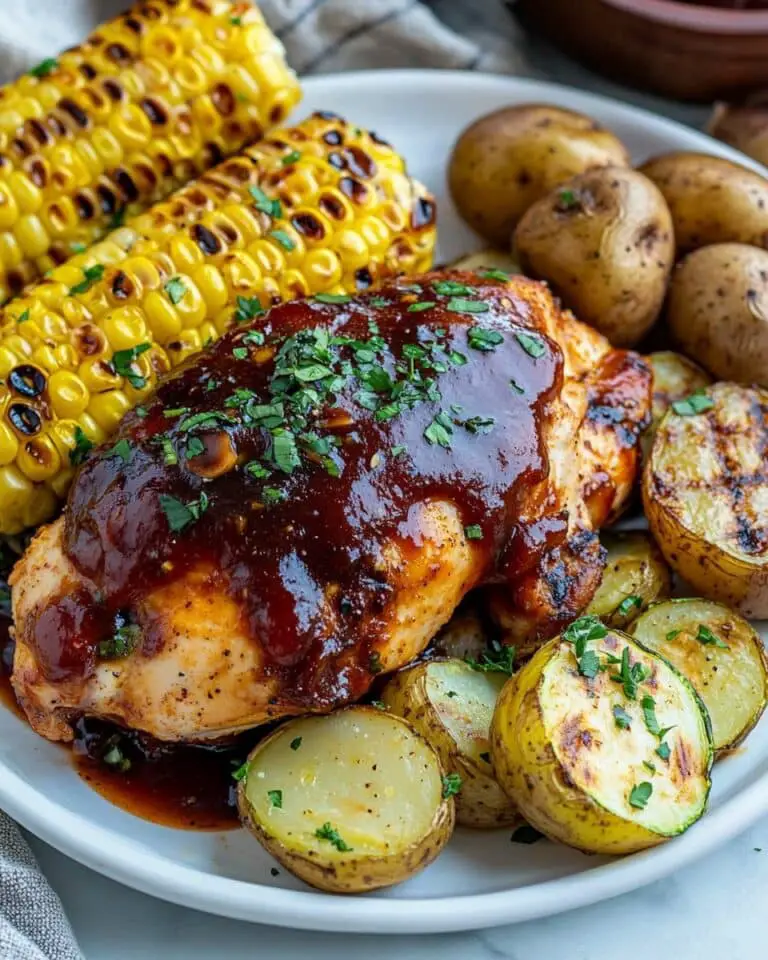This classic Denver Omelet is a breakfast champion – fluffy eggs packed with savory ham, colorful bell peppers, and onions, all brought together with melty cheddar cheese. It’s a restaurant-quality breakfast you can easily make at home in just 20 minutes, perfect for busy mornings when you want something satisfying and delicious!
Why You’ll Love This Recipe
- Quick and Satisfying: From start to finish in just 20 minutes – faster than a trip to your local diner!
- Perfect Texture: Achieving that magical balance of fluffy yet fully-cooked eggs with perfectly crisp-tender vegetables.
- Customizable: While staying true to the classic Denver flavors, you can easily adjust ingredients to suit your taste preferences.
- Restaurant Quality: This technique creates a beautiful omelet that looks and tastes like it was made by a professional chef.
Ingredients You’ll Need
- Eggs: The star of the show, providing protein and creating that fluffy base for all your fillings.
- Milk: Adds a touch of creaminess to your eggs, but completely optional if you prefer a denser texture.
- Butter: Creates a non-stick surface and adds richness – use unsalted so you can control the seasoning.
- Ham: Adds savory flavor and hearty texture; thick-cut ham gives you satisfying chunks throughout the omelet.
- Onions: Red onions bring a pleasant sweetness and beautiful color contrast.
- Bell Peppers: The signature Denver omelet ingredients, green and red peppers provide crunch, color, and fresh flavor.
- Cheddar Cheese: Melts perfectly and adds that irresistible gooey factor. The sharpness complements the ham beautifully.
- Green Onions: Added as a garnish for fresh flavor and a pop of color.
- Salt and Pepper: Simple seasoning that enhances all the other flavors.
Note: You’ll find the complete list of ingredients, along with their exact measurements, in the printable recipe card at the bottom of this post.
Variations
Want to switch things up? Here are some tasty options:
- Meat Lover’s Denver: Add crumbled bacon or breakfast sausage alongside the ham.
- Veggie-Packed: Incorporate mushrooms, tomatoes, or spinach for extra nutrition.
- Cheese Options: Switch the cheddar for Swiss, pepper jack, or a combination of your favorites.
- Southwestern Twist: Add a few tablespoons of salsa and swap the cheddar for Monterey Jack.
- Herb Enhancement: Mix in fresh herbs like chives, parsley, or dill to brighten the flavors.
How to Make Denver Omelet
Step 1: Prepare the Egg Mixture
Whisk the eggs, milk (if using), salt, and pepper in a medium bowl. Use a side-to-side motion until just combined – overbeating will incorporate too much air and affect the texture.
Step 2: Cook the Ham
Melt 1 teaspoon of butter in an 8-inch nonstick skillet over medium heat until bubbling but not browning. Add the diced ham and sauté until it develops a light golden-brown color, about 1½ to 2 minutes.
Step 3: Sauté the Vegetables
Add the diced red onions and bell peppers to the ham. Cook until they’re crisp-tender, approximately 2 minutes. You want them to soften slightly while maintaining some texture. Transfer everything to a bowl and wipe the pan clean.
Step 4: Cook the Eggs
Return the clean pan to medium-high heat and melt the remaining teaspoon of butter. Pour in the whisked eggs. As they begin to set, use a spatula to gently pull the cooked edges toward the center, tilting the pan to let the uncooked egg flow underneath. Continue this process, creating soft curds throughout the omelet for about 45-60 seconds.
Step 5: Add Fillings and Fold
When the eggs are mostly set but still slightly glossy on top, reduce the heat to low. Spread the ham and vegetable mixture over one half of the omelet, then sprinkle with cheddar cheese. Turn off the heat and cover the pan, allowing residual heat to melt the cheese and finish cooking the eggs, about 1-2 minutes.
Step 6: Serve
Use a spatula to carefully fold the empty half over the filled side, creating a half-moon shape. Slide onto a plate, sprinkle with green onions, and serve immediately while hot and fluffy.
Pro Tips for Making the Recipe
- Prep Everything First: Have all ingredients chopped and ready before starting to cook for a smooth process.
- Don’t Overcook: The key to a fluffy omelet is removing it from heat when the eggs are still slightly glossy on top.
- Pan Size Matters: An 8-inch nonstick skillet is perfect for a 2-egg omelet – too large and your eggs will be too thin.
- Low and Slow Finish: The covered resting period with the heat off allows the eggs to finish cooking gently without browning too much.
- Folding Technique: Use a thin, flexible spatula to fold the omelet without breaking it.
How to Serve

The Denver omelet makes a complete meal on its own, but here are some perfect pairings:
Morning Classics
Serve with crispy hash browns, buttered toast, or fresh fruit for a diner-style breakfast.
Brunch Spread
Include the omelet as part of a larger spread with bacon, sausage, pancakes, and mimosas.
Lunch Option
Pair with a simple green salad for a lighter midday meal that’s still satisfying.
Make Ahead and Storage
Storing Leftovers
While omelets are best enjoyed fresh, you can refrigerate leftovers in an airtight container for up to 2 days.
Freezing
I don’t recommend freezing Denver omelets as the texture will suffer significantly upon thawing.
Reheating
To reheat, microwave on 50% power for 30-second intervals until just warm. Avoid overheating which will make the eggs tough.
For meal prep, consider having all ingredients chopped and stored separately in the refrigerator so you can quickly throw together a fresh omelet in minutes.
FAQs
Can I make a Denver omelet without a nonstick pan?
Yes, but you’ll need to use more butter to prevent sticking. A well-seasoned cast iron skillet can work, but requires more attention to temperature control and may be trickier for folding.
What’s the difference between a Denver omelet and a Western omelet?
There’s virtually no difference! The Denver omelet (sometimes called a Western or Southwest omelet) traditionally contains ham, onions, and green peppers. Regional variations might include different cheese types or additional ingredients.
Why does my omelet always break when I try to fold it?
This typically happens when the eggs are overcooked before folding. Make sure to fold when the top is still slightly moist, and use medium-low heat for the final cooking stage. Also, a good nonstick pan and proper spatula make folding much easier.
Can I use egg whites instead of whole eggs?
Absolutely! Replace each whole egg with two egg whites. The texture will be lighter and less rich, but still delicious. You might want to add a pinch more seasoning since egg whites are milder in flavor.
A Denver omelet is one of those perfect breakfast classics that never goes out of style. With just a handful of ingredients and straightforward technique, you can create a restaurant-worthy breakfast at home any day of the week. The combination of savory ham, sweet peppers, and gooey cheese wrapped in fluffy eggs creates a satisfying meal that works just as well for dinner as it does for breakfast. Give this recipe a try – it might just become your new go-to breakfast!
Print
Denver Omelet Recipe
- Prep Time: 10 minutes
- Cook Time: 10 minutes
- Total Time: 20 minutes
- Yield: 1 serving 1x
- Category: Breakfast
- Method: Stovetop
- Cuisine: American
Description
A classic Denver omelet packed with savory ham, colorful bell peppers, and onions, all folded with melted cheddar cheese for a hearty breakfast that’s ready in just 20 minutes.
Ingredients
- 2 large eggs
- 2 teaspoons (20 ml) whole milk, optional
- 1/8 teaspoon kosher salt
- 1/8 teaspoon black pepper
- 2 teaspoons (10 g) unsalted butter, divided
- 1/4 cup (35 g) diced thick-cut ham, 1/4″ dice
- 1/4 cup (30 g) diced red onion, 1/4″ dice
- 2 tablespoons (15 g) diced green bell pepper, 1/4″ dice
- 2 tablespoons (15 g) diced red bell pepper, 1/4″ dice
- 2 tablespoons (15 g) cheddar cheese
- 1 tablespoon (2 g) sliced green onions
Instructions
- Whisk the Eggs – In a medium bowl, whisk together the eggs, milk (if using), salt, and pepper. Whisk in a side-to-side motion until uniform in appearance; do not over-mix. Set aside.
- Cook the Ham – In an 8-inch nonstick skillet, melt 1 teaspoon of butter over medium heat until it just begins to bubble and foam, but does not brown. Add the diced ham and saute until lightly browned, 1 ½ to 2 minutes.
- Saute the Vegetables – Add the diced onions, green bell pepper, and red bell pepper. Saute until crisp-tender, about 2 minutes. Transfer the ham and vegetables to a bowl. Wipe out the pan with a paper towel.
- Cook the Eggs – In the clean pan, heat 1 teaspoon butter over medium-high heat until it just begins to bubble and foam, but does not brown. Add the eggs and use a spatula to pull the cooked curds away from the edges and towards the center, allowing the raw egg to run underneath. Tilt the pan to help move the uncooked eggs to the bottom. Create curds around the entire omelet, this will take about 45 to 60 seconds. Once the eggs are mostly cooked, similar to soft scrambled eggs with a glossy and slightly wet surface, turn the heat down to low.
- Fill the Omelet – Add the ham and vegetables to one half of the omelet, then sprinkle on the cheddar cheese. Turn off the heat and move the pan to a cool part of the stove. Cover the omelet and allow it to finish cooking, about 1 to 2 minutes. Using a spatula, fold the other half of the omelet on top. The surface will be lightly golden brown.
- To Serve – Transfer the omelet to a plate and garnish with green onions. Serve immediately.
Notes
- Creamier Eggs: Add heavy cream instead of whole milk for richer texture.
- Butter Substitute: Use olive oil or vegetable oil to grease the pan for a different flavor profile.
- Ham Substitute: Use ham steak for nice chunks of meat, but sliced ham is a good substitute.
- For a Less Browned Surface: Use medium instead of medium-high heat when cooking the eggs.
- The Denver omelet (also called Western omelet) originated in the American West and was initially served between bread as a sandwich.
- For best results, use room temperature eggs as they cook more evenly.
Nutrition
- Serving Size: 1 omelet
- Calories: 312kcal
- Sugar: 3g
- Sodium: 780mg
- Fat: 22g
- Saturated Fat: 10g
- Unsaturated Fat: 10g
- Trans Fat: 0g
- Carbohydrates: 7g
- Fiber: 1g
- Protein: 23g
- Cholesterol: 380mg








